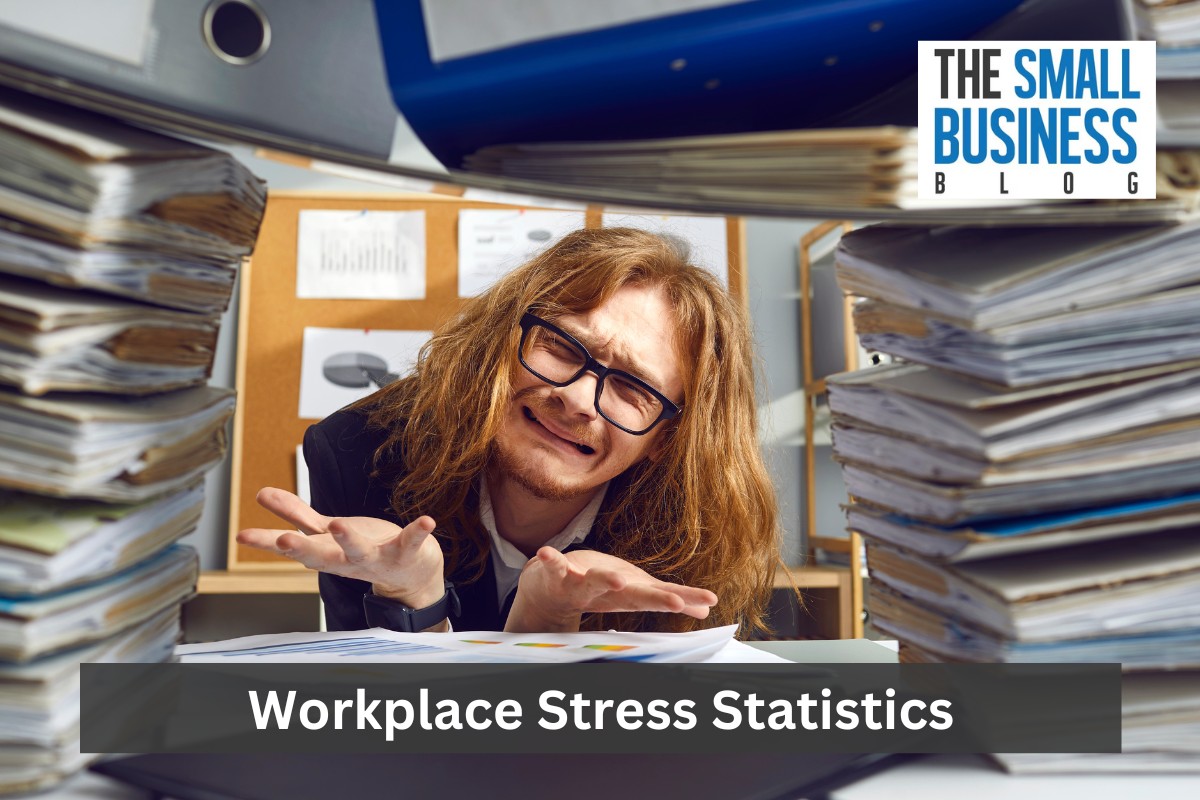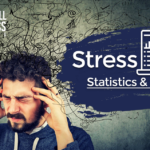Workplace stress is an unfortunate part of today’s workplace.
Most Americans experience levels of stress at work, but some stress is more manageable than other kinds of stress.
After doing the research on workplace stress statistics, we found that there are tons of studies on the subject and a lot more data than we can cover in a single article.
Therefore, we will be discussing the highlights and the most important statistics you need to know about stress in the workplace.
Workplace stress isn’t always something that happens at work and then subsides once you get home.
When work-related stress levels are high it’s hard not to bring that stress home with you.
You are soon to discover how work stress can affect your health, wellbeing, relationships, etc.
Let’s get into this topic so you can learn what we found for you.
Post Contents
- 1 Key Statistics
- 2 Top Workplace Stress Statistics in 2024
- 2.1 1. 59% of workers say they experience high-level stress at work.
- 2.2 2. 44% of surveyed workers said the pandemic increased their work stress in Europe.
- 2.3 3. At least 94% of workers experience chronic work stress.
- 2.4 4. 92% of American workers said it’s very important to work for a company that values their mental health.
- 2.5 5. 66% of American employees surveyed reported stress-related sleep deprivation in 2018.
- 2.6 6. 2013 data shows that $300 billion (USD) was spent each year due to missed work and healthcare.
- 2.7 7. Extreme work-related stress causes a shocking 120,000 deaths every year.
- 2.8 8. The global workplace stress management sector is expected to grow to $4.59 billion by 2027.
- 2.9 9. 99% of workers in America confirm that work stress affects their mental health.
- 2.10 10. 19% of workers in the United Kingdom said their employer has not put anything in place for work stress relief.
- 2.11 11. 52% of workers said that the lack of advancement and growth opportunities have an impact on work stress.
- 2.12 12. 56% of workers say they have looked for a new job due to stress levels at work.
- 2.13 13. 55% of surveyed American workers strongly believe that improvements are needed.
- 2.14 14. 75% of employees believe their stress is higher than in previous generations.
- 2.15 15. 48% of burnout has been experience among workers in the U.K. over the past 12 months.
- 2.16 16. 54% of women and 47% of men experience work-related stress.
- 2.17 17. In the U.K., 39% of companies have workplace stress reduction policies for those who work from home.
- 2.18 18. Calling into work sick rose instance rose between 1996 to 2000.
- 2.19 19. 41% of employees in large companies and 40% in small companies say poor communication is a stressor.
- 2.20 20. Only 43% of workers in America reported that their employers offer health coverage that include mental healthcare.
- 3 FAQs
- 4 Conclusion
Key Statistics
- 62% of workers say they experience high-level stress at work.
- 44% of surveyed workers said the pandemic increased their work stress in Europe.
- At least 94% of workers experience chronic work stress.
- 92% of American workers said it’s very important to work for a company that values their mental health.
- 66% of American employees surveyed reported stress-related sleep deprivation
- 2013 data shows that $300 billion (USD) was spent each year due to missed work and healthcare.
- Extreme work-related stress causes a shocking 120,000 deaths every year.
- The global workplace stress management sector is expected to grow to $4.59 billion by 2027.
- 99% of workers in America confirm that work stress affects their mental health.
- 19% of workers in the U.K. said their employer hasn’t put anything in place for work stress relief.
Top Workplace Stress Statistics in 2024

1. 59% of workers say they experience high-level stress at work.
In the ComPsychⓇ 2017 StressPulseSM Report, 59% of employee participants revealed that they are in the high-stress category.
Study in 2013 by this same source revealed that 62% of employees experienced high-level work stress.
(AIS, ComPsychⓇ 2017)
2. 44% of surveyed workers said the pandemic increased their work stress in Europe.
This data shows us that workplace stress isn’t exclusive to any one country or region.
At 44% in a 2022 survey, that’s nearly half of the workers who responded in this survey.
Therefore, we can surmise that COVID-19 did increase workplace stress that has had a lasting effect.
(OSHA Europa)
3. At least 94% of workers experience chronic work stress.
An AIS survey of 1,600 American and United Kingdom employees revealed that at least 94% report feel stressed in the workplace.
Of this 94%, nearly one-third reported that their stress levels are either “high or unsustainably high”.
Unsustainably high stress levels can have their adverse side effects no matter where you live or work.
(AIS², CFAH, Wrike)
4. 92% of American workers said it’s very important to work for a company that values their mental health.
A 2022 survey conducted by the Surgeon General revealed that 92% of American workers feel it’s very important for them to work for a company that values their psychological and emotional wellbeing.
Another 92% said it’s very important to them to work for a company that provides support for their employees’ mental health.
(APA)
5. 66% of American employees surveyed reported stress-related sleep deprivation in 2018.
It’s not unusual for stress to cause sleep problems like insomnia which may eventually result in sleep deprivation.
In fact, 66% of surveyed American workers say they have experienced sleep deprivation due to work stress.
Over half of the survey respondents said they frequently work 12-hour shifts daily, and another half said they skip lunch due to high-level workplace demands and stress.
(Zippia)
6. 2013 data shows that $300 billion (USD) was spent each year due to missed work and healthcare.
Work-related stress causes missed workdays and doctor visits to the tune of over $300 billion each year in the United States.
This comes from an AIS study from 2013.
The report states that the cost of job stress accounts for over $300 billion to organizations all over the country.
The losses include absenteeism, accidents/injuries, and reduced productivity.
(AIS, LinkedIn)
7. Extreme work-related stress causes a shocking 120,000 deaths every year.
Studies show that each year 120,000 deaths are caused from excessive stress in the workplace.
Not only does it cause these massive deaths, but it also costs almost $190 billion (USD) year in healthcare costs in America.
Stress in the workplace is more serious than you might think.
(Gitnux)
8. The global workplace stress management sector is expected to grow to $4.59 billion by 2027.
As of 2022, the market for workplace stress management is estimated at $2.01 billion (USD).
However, it’s expected to grow at a CAGR of 11.94% and is expected to reach $4.59 billion (USD) by 2027.
That’s just under four years from now.
(Research And Markets)
9. 99% of workers in America confirm that work stress affects their mental health.
Further research from American workers confirms that 99% of them agree that workplace stress has adverse effects on mental wellbeing.
Moreover, the study revealed that 83% say they are emotionally drained due to stress at work.
Other statistics show that 62% said they have work stress related neck pain, 44% stressed eyes, and 34% said they have sleep problems.
(CFAH)
10. 19% of workers in the United Kingdom said their employer has not put anything in place for work stress relief.

In the United Kingdom, 19% of workers surveyed claimed that their employers have yet to put a plan in motion for work-related stress relief.
Even though the number of U.K. workplaces has been cut in half in terms of implementing workplace stress relief for workers since 2018, there is still work to be done in this realm.
(Perkbox, Spill)
11. 52% of workers said that the lack of advancement and growth opportunities have an impact on work stress.
There are ample reasons for people to be stress at work, but one stands out in 52% of American workers.
In 2021, 52% of workers confirmed that the lack of growth and advancement opportunities contributed to work stress levels.
In 2019, that figure was 44%.
Could the pandemic have been the cause of the rise?
(AIS)
12. 56% of workers say they have looked for a new job due to stress levels at work.
One of the things unhappy employees do is search for a better job.
In this instance, 56% of workers said they searched for a new job because of stress levels in their current company.
This is not just about being unhappy.
It’s about setting boundaries and looking for a workplace with a better culture and atmosphere that fits your own values.
Undue and excessive workplace stress is a top reason workers search for other jobs.
Toxic workplace environments lead to this kind of conclusion.
(Wrike)
13. 55% of surveyed American workers strongly believe that improvements are needed.
In terms of workplace stress, 55% of American workers strongly believe that improvements are still needed in the workplace to reduce and help with stress management.
Another 21% said they somewhat agree there’s work left to do in this realm.
(APA)
14. 75% of employees believe their stress is higher than in previous generations.
Research is showing that stress levels in the workplace are going up because of higher expectations, competition, and the lack of staffing or resources.
Our current generation of workers are experiencing so much workplace stress that many are nearing burnout levels.
In fact, 75% of current workers say they experience higher stress levels than their generational predecessors.
(Zippia)
15. 48% of burnout has been experience among workers in the U.K. over the past 12 months.
We know that workplace stress can happen to anyone on the globe.
However, 48% of workers in the United Kingdom are experiencing burnout due to stress at work.
One in 10 adults in the United Kingdom say their boss stresses them out.
Also, 72% of full-time workers in the United Kingdom think that annual leave is an effective way to reduce burnout.
(Gitnux)
16. 54% of women and 47% of men experience work-related stress.
In a 2022 Gallup report, 50% of Northern American workers experience stress at with many times each day.
Most of these workers are women at 54%.
This is likely due to working mothers who deal with working outside the home and then deal with household tasks at home.
It’s like a double whammy for some of them.
Among men the percentage of those who have job stress is 47% in comparison.
(CFAH)
17. In the U.K., 39% of companies have workplace stress reduction policies for those who work from home.
Although people who work from home say they are happier and have less work stress, they still get stressed.
It’s enough that 39% of companies with people who work for them from home have policies to mitigate workplace stress.
Another 37% allow flexible hours and one-on-ones to mitigate stress.
Finally, 33% of companies in the U.K. provide counseling for workers to help reduce work-related stress.
(Perkbox, Spill, Statista)
18. Calling into work sick rose instance rose between 1996 to 2000.
There was a significant rise in workers calling in sick from work between 1996 and 2000.
It’s estimated that absenteeism occurs daily among one million employees because of workplace stress.
If you’re an employer, this rise should concern you.
If you don’t include mental health plans in your policies at work, maybe you should consider it.
(AIS)
19. 41% of employees in large companies and 40% in small companies say poor communication is a stressor.
Among employees of large companies with 1,000-plus workers 41% say that poor communication is the top stressor at work.
Among employees at small companies, 40% of them said the same about poor communication.
Number two is team members not pulling their weight on the job (40% from large companies and 27% from small ones).
(Wrike)
20. Only 43% of workers in America reported that their employers offer health coverage that include mental healthcare.

Not all employers who offer health insurance to their workers have mental healthcare on their plans for employees.
In fact, only 43% of companies in America do offer mental health coverage as part of their health insurance plans.
Imagine as an employer how you could potentially mitigate absenteeism, healthcare expenses, and lost productivity by adding mental health coverage, or at least a specific company policy.
(APA)
FAQs
What are signs of workplace stress?
If you’re unsure whether you’re experiencing workplace stress, here are some things that can help you recognize what’s happening.
1. Feelings of overwhelm combined with negative emotions and thoughts.
2. A loss of confidence in things you know how to do well, but you feel like an imposter in your own role.
3. You may feel withdrawn, angry, or irritable more than usual.
4. Feeling anxious, apathetic, depressed at work and at home.
Also, you may experience headaches, fatigue, difficulty focusing and concentrating, muscle tension insomnia, loss of interest in your work, issues with digestion, using drugs or alcohol to numb your feelings, or even social withdrawal.
How do you manage workplace stress at work?
It’s going to take some time, but you need to start setting boundaries at work.
Take time off when you need it, communicate with your superior about boundaries and limits that you need.
Learn to prioritize work tasks and take breaks when you’re feeling overwhelmed or overworked.
You don’t have to live with uncertainty.
Make sure to communicate effectively and learn to get feedback from your coworkers or your boss regarding your stress.
How do you manage workplace stress away from work?
Since stress usually follows you wherever you go after work, you need to compartmentalize things to manage work stress outside of the workplace.
This may also include setting boundaries with your colleagues and superiors.
A good example is to let them know you don’t take calls after work hours.
Set a time limit on work calls after work if you need to take work calls for a little bit after the workday, but don’t accept intrusions.
Avoid constantly checking your emails and block your calendar out after a specified time so people know you’re unavailable at those times.
Taking baby steps in setting such boundaries and prioritizing your life outside of work is a good start.
Conclusion
Now we know that workplace stress has been widely studied and researched for several years.
It’s hard to explain to someone who has never worked or experienced elevated levels of work-related stress just how bad it can make you feel.
However, we also now understand there are ways to make changes in your life to reduce stress, and to cope better and manage stress.
For instance, you can take a little time to reflect on your week, pay attention to what stresses you, and build a plan to make your next work week better.
It’s important to pay attention to your body and mind so you can avoid work-related stress that can result in burnout, major health problems, and challenges with your mental health.
Let’s just say that the ability to identify your stressors is where you start to understand what triggers your stress.
From there, you can begin to mitigate the effect it’s having on you.
Self-care and mindfulness are two things you need at work and in every aspect of your life.
We hope you have learned something of value from these workplace stress statistics.






























